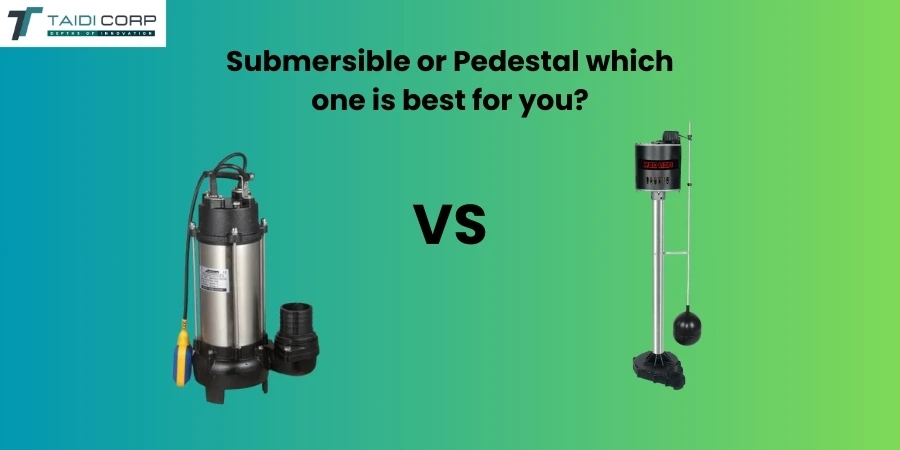
Choosing the right sewage pump is crucial for managing wastewater effectively in your home or business. Whether you’re a homeowner considering installation or replacement, a property manager ensuring smooth operations, a plumbing professional advising clients, or a DIY enthusiast tackling a home project, understanding the differences between submersible and pedestal sewage pumps is essential. This guide provides a comprehensive comparison to help you make an informed decision.
Overview of Sewage Pumps
Function of Sewage Pumps
Sewage pumps play a vital role in managing wastewater, ensuring it is efficiently transported away from your property to prevent backups and flooding. They are integral in maintaining the hygiene and functionality of residential and commercial buildings by handling sewage from toilets, sinks, and other drainage systems.
Purpose of the Guide
This guide aims to compare submersible vs. pedestal sewage pumps, highlighting their key features, advantages, and disadvantages. By providing a detailed comparative analysis, we help you determine which sewage pump type best suits your specific needs.
Who Should Read This Guide
- Homeowners considering installing or replacing a sewage pump.
- Property managers and landlords overseeing multiple properties.
- Plumbing professionals advising clients on sewage pump options.
- DIY enthusiasts researching sewage pump types for home projects.
What are Submersible Sewage Pumps?
Definition and Design
Submersible sewage pumps are designed to operate underwater. The motor and pump are housed in a single unit placed inside the sewage basin, making them an integrated solution for wastewater management.
How They Work
These pumps activate when the float switch detects a certain water level, automatically pumping waste to the main sewage line or septic tank. Their submerged placement allows for efficient handling of large volumes of wastewater.
Common Applications
- Residential Basements: Prevents basement flooding by efficiently removing excess water.
- Sump Systems: Integral to sump pumps in basements and crawl spaces.
- Areas Prone to Flooding: Ideal for locations where water accumulation is a common issue.
What are Pedestal Sewage Pumps?
Definition and Design
Pedestal sewage pumps feature the motor located above the basin, with only the pump submerged. The motor is mounted on a pedestal above the basin, keeping it dry and easily accessible.
How They Work
The motor activates the impeller in the submerged portion, pushing waste through the discharge pipe. This separation of the motor and pump allows for easier maintenance and repair.
Common Applications
- Shallow Basins: Suitable for locations where the sewage basin is not deep.
- Maintenance-Friendly Areas: Ideal for settings where easy access for repairs and inspections is a priority.
Key Differences Between Submersible and Pedestal Sewage Pumps
Design and Installation
| Feature | Submersible Pumps | Pedestal Pumps |
|---|---|---|
| Design | Fully enclosed, operates underwater | Motor exposed above ground |
| Installation | More complex, requires waterproofing | Easier, motor mounted on pedestal |
| Noise Levels | Quieter operation | Louder due to exposed motor |
Noise Levels
Submersible pumps are generally quieter since they are submerged and insulated by water. In contrast, pedestal pumps can be noisier because the motor operates above ground and is not as well insulated.
Durability and Lifespan
Submersible pumps typically have shorter lifespans due to constant exposure to water and waste but are built to handle harsh conditions. Pedestal pumps, with their motor kept dry, often last longer and are easier to repair or replace.
Efficiency and Performance
Submersible pumps can handle larger volumes of wastewater and solid materials, making them suitable for high-capacity needs. Pedestal pumps are generally less powerful, better suited for light-duty applications where high capacity is not required.
Maintenance
| Aspect | Submersible Pumps | Pedestal Pumps |
|---|---|---|
| Access for Repairs | Harder to access, submerged | Easier to access, motor above |
| Cleaning | More challenging due to submerged placement | Simpler, motor accessible |
Submersible pumps are harder to access for repairs or cleaning since they are submerged. Pedestal pumps offer easier access to the motor and pump for maintenance without the need to remove the entire unit.
Advantages of Submersible Sewage Pumps
Quiet Operation
The submersion of the pump in water significantly dampens noise, making submersible pumps ideal for indoor use where noise levels are a concern.
Higher Efficiency
Submersible pumps are capable of handling larger volumes of waste and solid materials, ensuring efficient wastewater management even in high-capacity systems.
Safety
Their enclosed design reduces the risk of electrical hazards or motor damage from flooding, providing a safer solution for wastewater management.
Advantages of Pedestal Sewage Pumps
Longer Lifespan
With the motor kept out of the water, pedestal pumps experience less wear and tear, often resulting in a longer operational lifespan compared to submersible pumps.
Easy Maintenance
The elevated motor and pump design make it easier to access for repairs and inspections, reducing downtime and maintenance costs.
Cost-Effectiveness
Pedestal pumps are generally more affordable upfront and cheaper to repair or replace, making them a cost-effective choice for many applications.
Disadvantages of Each Pump Type
Submersible Pumps
- More Expensive: Higher initial cost and more complex installation.
- Shorter Lifespan: Constant exposure to water and debris can reduce longevity.
Pedestal Pumps
- Louder Operation: Exposed motor can create more noise.
- Less Durable: The exposed motor may be less durable in harsh environments.
- Lower Efficiency: Not ideal for high-capacity needs due to less powerful performance.
Which Sewage Pump is Right for You?
Choosing Based on Application
- Submersible Pump:
- Best for basements, high-capacity systems, and areas where noise is a concern.
- Pedestal Pump:
- Ideal for smaller applications, shallow basins, and where easy access for maintenance is needed.
Considerations for Homeowners
- Budget: Consider both upfront costs and long-term maintenance expenses.
- Space Constraints: Ensure the pump fits within the available space.
- Maintenance Preferences: Decide how much maintenance you’re willing to perform.
- Desired Lifespan: Factor in the longevity of the pump type.
Considerations for Businesses
- High-Capacity Needs: Ensure the pump can handle the volume of wastewater.
- Ease of Access: Prioritize pumps that are easy to maintain to minimize downtime.
- Noise Tolerance: Consider the noise levels acceptable for your business environment.
Installation and Maintenance Tips
Professional Installation vs. DIY
While DIY installation is possible for those with plumbing experience, professional installation is recommended to ensure proper setup, compliance with local codes, and optimal performance. Professional plumbers can also provide valuable advice tailored to your specific needs.
Basic Maintenance Tips
- Regular Inspections: Periodically check the pump for signs of wear or damage.
- Cleaning: Keep the pump and basin clean to prevent blockages and buildup.
- Testing: Regularly test the pump to ensure it activates and operates correctly.
Conclusion
Choosing between a submersible and pedestal sewage pump depends on your specific needs, budget, and application. Submersible pumps are ideal for high-capacity, quieter operations, especially in basements and areas prone to flooding. Pedestal pumps offer easier maintenance, longer lifespans, and cost-effectiveness, making them suitable for smaller applications and shallow basins.
Assess your property’s requirements and consider factors like budget, space, maintenance preferences, and desired lifespan before making a decision. For complex setups or personalized advice, consulting a professional plumber can provide additional guidance tailored to your situation.
Have questions or specific needs? Share them in the comments below! For more information on sewage pumps and other plumbing solutions, visit our All Products page.
